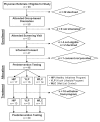One-on-one lifestyle coaching for managing adolescent obesity: Findings from a pilot, randomized controlled trial in a real-world, clinical setting
- PMID: 22654546
- PMCID: PMC3328223
- DOI: 10.1093/pch/16.6.345
One-on-one lifestyle coaching for managing adolescent obesity: Findings from a pilot, randomized controlled trial in a real-world, clinical setting
Abstract
Background: Interventions for obese adolescents in real-world, clinical settings need to be evaluated because most weight management care occurs in this context.
Objectives: To determine whether a lifestyle intervention that includes motivational interviewing and cognitive behavioural therapy (Health Initiatives Program [HIP]) leads to weight management that is superior to a similar lifestyle intervention (Youth Lifestyle Program [YLP]) that does not include these techniques; and to determine whether the HIP and YLP interventions are superior to a wait list control (WLC) group.
Methods: Obese adolescents were randomly assigned to a YLP (n=15), HIP (n=17) or WLC (n=14) group. The YLP and HIP were 16-session, one-on-one interventions. The primary outcome was the percentage change of body mass index z-score.
Results: Completers-only analyses revealed 3.9% (YLP) and 6.5% (HIP) decreases in the percentage change of body mass index z-score compared with a 0.8% (WLC) increase (P<0.001). Levels of attrition did not differ among groups, but were relatively high (approximately 20% to 40%).
Conclusion: Lifestyle interventions delivered in a real-world, clinical setting led to short-term improvements in the obesity status of adolescents.
HISTORIQUE :: Il faut évaluer les interventions auprès des adolescents obèses en milieu clinique réel parce que la plupart des soins de prise en charge de l’obésité se produisent dans ce contexte.
OBJECTIFS :: Déterminer si une intervention sur le mode de vie, incluant une entrevue motivationnelle et une thérapie cognitivocomportementale (Health Initiatives Program [HIP]), favorise une gestion du poids plus efficace qu’une intervention similaire sur le mode de vie (Youth Lifestyle Program [YLP]) qui exclut ces techniques; et déterminer si les interventions HIP et YLP sont plus efficaces qu’un groupe témoin sur une liste d’attente (TLA).
MÉTHODOLOGIE :: Les adolescents obèses ont été répartis au hasard entre un groupe d’YLP (n=15), de HIP (n=17) ou de TLA (n=14). Les groupes d’YLP et de HIP ont reçu 16 séances d’interventions individualisées. L’issue primaire était le changement en pourcentage de l’écart réduit d’indice de masse corporelle.
RÉSULTATS :: Les analyses de ceux qui avaient terminé l’étude ont révélé des diminutions de 3,9 % (YLP) et de 6,5 % (HIP) du changement en pourcentage de l’écart réduit d’indice de masse corporelle, par rapport à une augmentation de 0,8 % (TLA) (P<0,001). Les taux d’attrition, relativement élevés, demeuraient les mêmes entre les groupes (environ 20 % à 40 %).
CONCLUSION :: Les interventions sur le mode de vie offertes en milieu clinique réel entraînent une amélioration à court terme de l’état d’obésité des adolescents.
Keywords: Adolescent; Intervention; Obesity.
Figures
References
-
- Shields M. Overweight and obesity among children and youth. Health Rep. 2006;17:27–42. - PubMed
-
- Statistics Canada . Annual Demographic Statistics, 2005. Ottawa: Statistics Canada; 2006.
-
- Ball GD, Lenk JM, Barbarich BN, et al. Overweight children and adolescents referred for weight management: Are they meeting lifestyle behaviour recommendations? Appl Physiol Nutr Metabol. 2008;33:936–45. - PubMed
-
- Spear BA, Barlow SE, Ervin C, et al. Recommendations for treatment of child and adolescent overweight and obesity. Pediatrics. 2007;120(Suppl 4):S254–88. - PubMed
LinkOut - more resources
Full Text Sources
Medical

